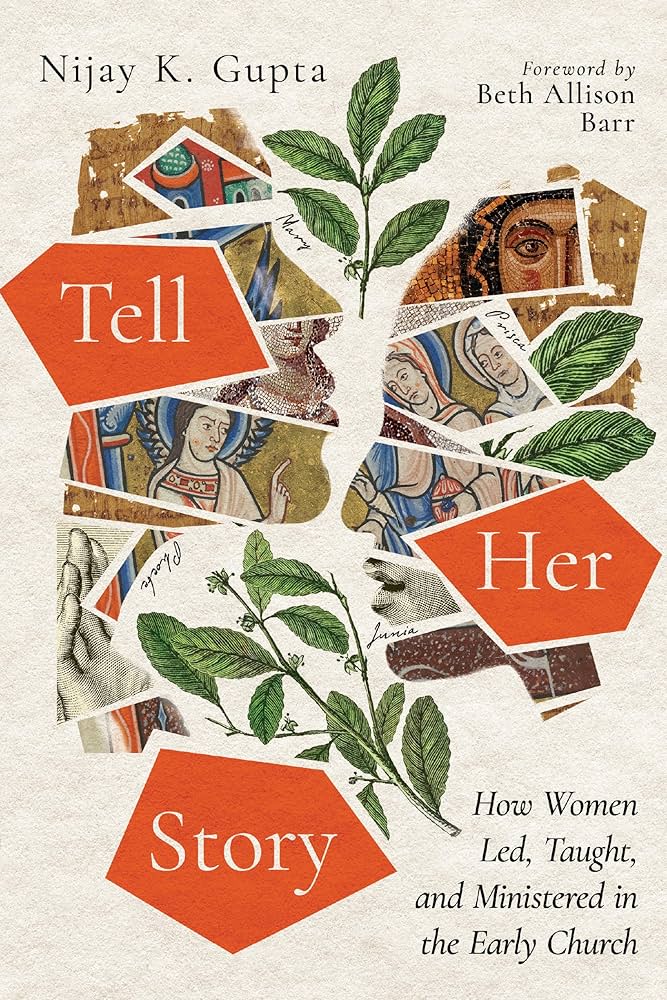Book Review: “Tell Her Story: How Women Led, Taught, and Ministered in the Early Church”
By: Jordan Atkinson

Editor’s Note: The following review appears in the Spring 2025 issue of Eikon.
Nijay K. Gupta. Tell Her Story: How Women Led, Taught, and Ministered in the Early Church. Downers Grove, IL: IVP Academic, 2023.
Tell Her Story by Nijay Gupta is a recent book defending egalitarianism on the basis that the Bible itself is egalitarian. Though this general argument is decades-old, Gupta gives it new life by systematically contending that many women in the Bible exercised leadership, whether domestically, ecclesiastically, or politically. In Gupta’s own words, Tell Her Story is “an exercise in amplification” (3). He argues that biblical women have been underappreciated as positive examples of spiritual leadership, and he aims to give them due consideration and honor.
Summary
Gupta sets the stage for his primary argument, that the New Testament provides many examples of women leading in homes and in churches, by claiming that both the Old Testament and the early church’s surrounding Jewish and Roman cultures provided antecedents for women leading in the early Christian movement. He first discusses Deborah, a prophetess who also provided political leadership during Israel’s early history as a nation. He then claims that Adam and Eve were equal partners in the Garden of Eden before sin tainted male-female relationships. Finally, Gupta shows that, though both first-century Jewish and Roman cultures were patriarchal, some women did provide leadership in their homes and in society. Within these contexts, Gupta contends that Jesus’ female followers (especially his mother, Mary, and Mary Magdalene) were influential over his male disciples. Drawing especially from Colossians 4:15, Philemon 1:1, and Romans 16, Gupta then argues that some women were deacons, overseers, and even elders in early churches. Finally, in two appendices, Gupta answers objections to his thesis that may be raised from 1 Timothy 2:11–15 and the New Testament household codes (Col 3:18–4:1; Eph 5:22–33; 1 Pet 3:1–6).
Critical Evaluation
Throughout Tell Her Story, Gupta writes clearly and compellingly in an appropriate tone, as an experienced professor who wants to help his readers appreciate women’s leadership according to the Bible. However, the egalitarian interpretation of the New Testament in this book is unconvincing for at least three reasons.
First, logical fallacies pervade this book. Gupta occasionally makes hasty generalizations. Deborah’s prophetic and political leadership of Israel in Judges 4–5 is a singular example of a woman leading in Old Testament Israel. Later, Gupta provides evidence of high-class Roman women sometimes having a measure of financial independence from their husbands or having managerial status within their households. Yes, there were “actual women who held positions of authority and power … who found ways to circumvent certain cultural rules and expectations” (6). But possibility does not amount to probability or actuality. Gupta also often constructed straw men with which to argue. He asks, “Did Jesus have women disciples?” (62). No complementarian denies that women followed Jesus. Gupta later says, “Women populate Scripture as examples of faith and obedience” (154). Everyone agrees that Scripture speaks highly of both men and women of faith. As a final example, consider how Gupta heads one section of his conclusion: “Paul saw no deficiency of intellect, skill, or morality in women” (158). Gupta’s historical and exegetical observations pose no problem to a complementarian reading of Scripture. His conclusion that early New Testament churches were egalitarian does not follow from these statements. Logical fallacies such as these hinder this book’s argument receiving a warmer reception.
Second, Gupta’s arguments that women led and taught in the early church are speculative. As Gupta begins to discuss Romans 16, the single chapter he treats most extensively, he makes multiple speculative assertions about Romans 16 without any supporting evidence: “Paul was explicitly commending women’s ministry and leadership …. The casual intermixture of male and female names (some couples, some singles or widows), and the general terminology used to describe their ministry work, point to a nongendered conception of leadership” (98–99). He jumps from calling Mary “one of the founding members of the Roman church” to saying, “it is not a stretch of the imagination to think that Mary was a leading elder at Rome” (101). A church may have many founding members, but almost all of them are not its elders, either initially or later. Finally, Gupta assumes that Lydia, as a householder in Philippi, would have been an overseer of the Philippian church, since she, lacking a husband, would have been overseer of her household (104). Gupta’s many speculations weaken the force of his overall argument.
Third, the broad egalitarian reading Gupta proposes for the Bible is sometimes self-contradictory. As an example of the underappreciation of female heroes of the faith, Gupta claims, “It is a curiosity to me that Hebrews mentions Barak but not Deborah (Heb 11:33). I can only assume that Hebrews was especially identifying warriors trained for battle” (10n2). To downplay a biblical author’s appreciation of women, Gupta here fails to observe that both Sarah and Rahab are commended in the “hall of faith” (Heb 11:11, 31). Later, Gupta says, “I find it incredibly clarifying to look at specific people in God’s good news story and how the biblical writers actually reflect on those people” (153). Isn’t the premise of his book that these women were underappreciated — even in Scripture — and that he must reconstruct their significance based on scant evidence? Other times, Gupta contradicts the Bible itself. He claims, “Paul did not seek to restrict women in terms of leadership or the wielding of power,” as Paul was “a ministry pragmatist” (49). This statement directly contradicts 1 Corinthians 14:33–36 (which Gupta never engages) and 1 Timothy 2:11–15, as well as the many texts in which Paul proves himself rather impractical by worldly standards. Finally, Gupta’s treatment of 1 Timothy 2:11–15 itself is self-defeating. Gupta endorses Cynthia Westfall’s scholarship on the key term authenteo (1 Tim 2:12), that this verb “expresses abuse of power, not neutral or positive use of power” (172). He considers Paul to be forbidding women to abuse power over men in first-century Ephesus. Let us grant this definition of authenteo. Even if authenteo only refers to the abuse of power, in Paul’s worldview, any exercise of authority by a woman over men within the church is a usurpation of authority, a wrong use of authority, because that authority is not hers to use at all. The definition of authenteo proposed by Westfall and Gupta does not, in fact, support egalitarianism. Gupta’s book shows that an egalitarian interpretation of Scripture continues to be self-contradictory and impossible to square with all the biblical data regarding the roles of men and women within the church.
Conclusion
Gupta has succeeded in his stated goal to amplify the narratives about women leaders of the Bible. However, as one reads, the amplification is so loud that it degenerates into distortion. In Tell Her Story, Gupta has turned the volume up too high on biblical women, such that his speculations regarding their leadership functions in the early church fail to be persuasive to those not already agreeing with his egalitarian presuppositions. Tell Her Story helpfully catalogs standard egalitarian arguments for a biblical basis for the equal roles of men and women in the church, but complementarians have already biblically refuted all these claims.
